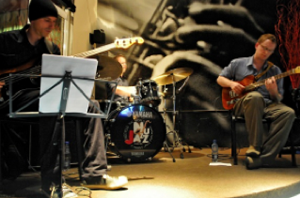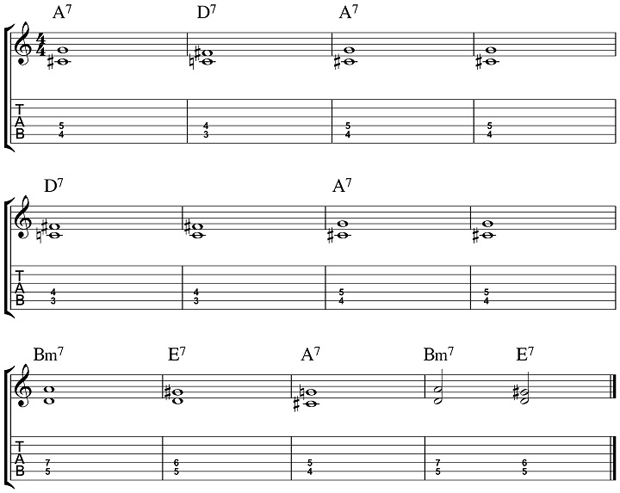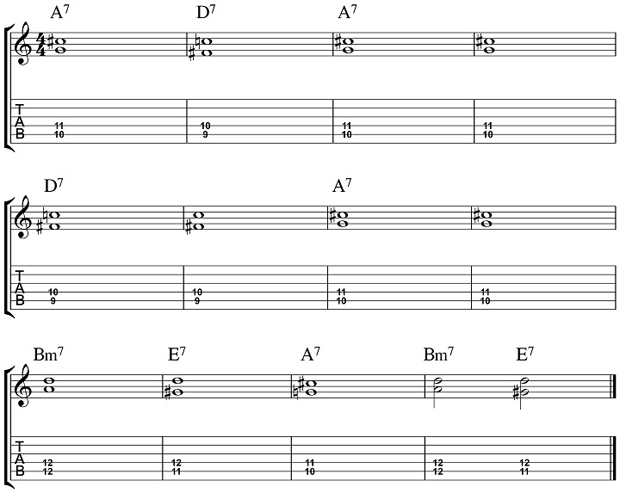Jazz Guitar Corner: Using Two-Note Chords to Play the Blues, Part 2

As we discovered in the first part of this series on 3rd and 7th chord voicings, sometimes all you need to properly and musically outline any chord progression is two chords.
Today, we’ll be continuing our exploration of these fun and easy-to-play jazz guitar shapes by looking at how to apply 3rd and 7th two-note chords to the fourth and fifth strings of the guitar.
After you’ve gone through these first two lessons, you’ll be ready to start adding color tones on top of these chords, taking these small but powerful chords to the next level in your comping, chord melody and chord soloing ideas.
To recap the first article in this series, visit “Using Two-Note Chords To Play the Blues, Part 1.”
What Are 3rd and 7th Chords?
As this was discussed in detail in the first lesson in this series, I’ll just do a quick review here for all of those readers that are new to the subject. 3rd and 7th chords are simply what their name implies — chord shapes built from the 3rd and 7th of the underlying chord symbol.
These two-note chords allow you to state whether the chord is major or minor (the 3rd takes care of this), as well as if the chord is a maj7, 7 or m7 (the 7th takes care of those).
Here's how you'd build and play the 3rd and 7th of an A7 chord on the fourth and fifth strings of the guitar.

The one chord that isn’t fully outlined with 3rds and 7ths, at least from the four basic jazz chord types, is the m7b5 chord. We’ll look at this chord closer in an upcoming column.
3rds and 7ths Over A Blues Chords
Now that you know how to build 3rd and 7th chords, let’s take them to a blues in A chord progression, with a jazzy ii-V thrown into bars 9 and 10 for good measure.
We’ll start with the 3rd and 7th for the A7 chord, then move with as little movement as possible to all of the other chords in this progression. As you can see and hear, these chords will fully outline any chord progression, including the blues, and you need only one or two fingers to play them. Pretty cool, right?
Also, notice how little movement there is between shapes as you move between chords. This type of voice leading isn't only good musical practice; it also allows you to quickly and smoothly move between any chord in the A blues progression.

And here is the inversion of those chords to check out over an A jazz blues progression. So you now have the 7th and 3rd for the first A7 chord, playing the rest of the chords close to that starting shape from there.

Practicing 3rds and 7ths Over the Blues
Now that you've checked out these chords over a blues in A, here are some more exercises you can do in order to expand on these two-note chords in your practice routine.
- 01.Play the 3rds and 7ths through a jazz blues progression, moving between the fourth and fifth as well as the third- and fourth-string shapes.
- 02.Sing the bass notes for each chord as you do the first exercise, then repeat this in all 12 keys
- 03.Solo over a jazz blues progression, play single-note lines for two bars, then 3rds and 7ths for two bars
- 04.Repeat exercise 3, but now alternate one bar of soloing and one bar of 3rds and 7ths
- 05.Learn your favorite jazz guitar ii-V-I line, but now add in the 3rds and 7ths below the line, to make it sound like two hands of a piano.
Do You have a question about these cool-sounding blues chords? Post your thoughts in the COMMENTS section below!
Matt Warnock is the owner of mattwarnockguitar.com, a free website that provides hundreds of lessons and resources designed to help guitarists of all experience levels meet their practice and performance goals. Matt lives in the UK, where he is a lecturer in Popular Music Performance at the University of Chester and an examiner for the London College of Music (Registry of Guitar Tutors).
Get The Pick Newsletter
All the latest guitar news, interviews, lessons, reviews, deals and more, direct to your inbox!
Matt Warnock is the owner of mattwarnockguitar.com, a free website that provides hundreds of lessons and resources designed to help guitarists of all experience levels meet their practice and performance goals. Matt lives in the UK, where he teaches Skype guitar students all over the world, and is an examiner for the London College of Music (Registry of Guitar Tutors).










